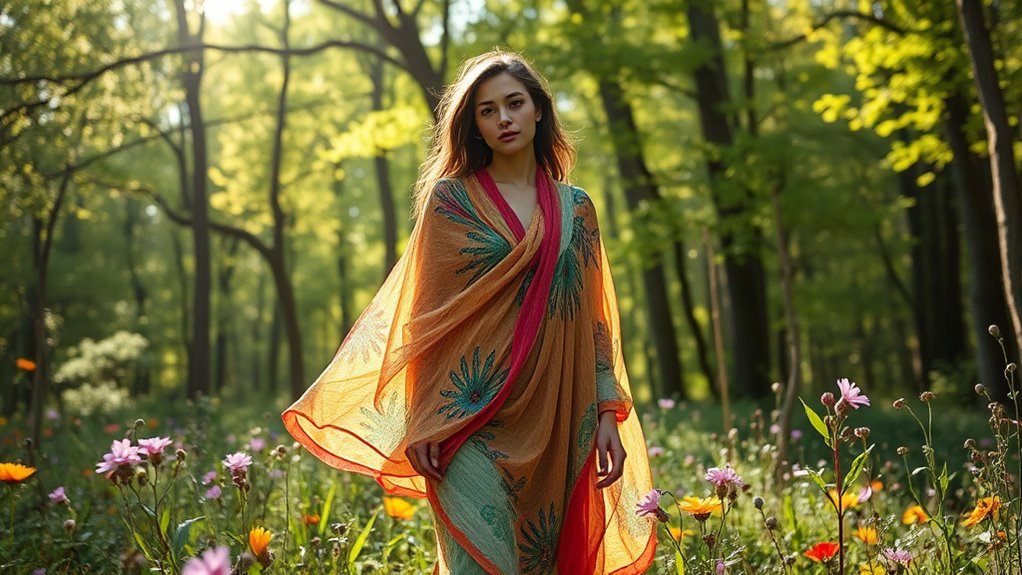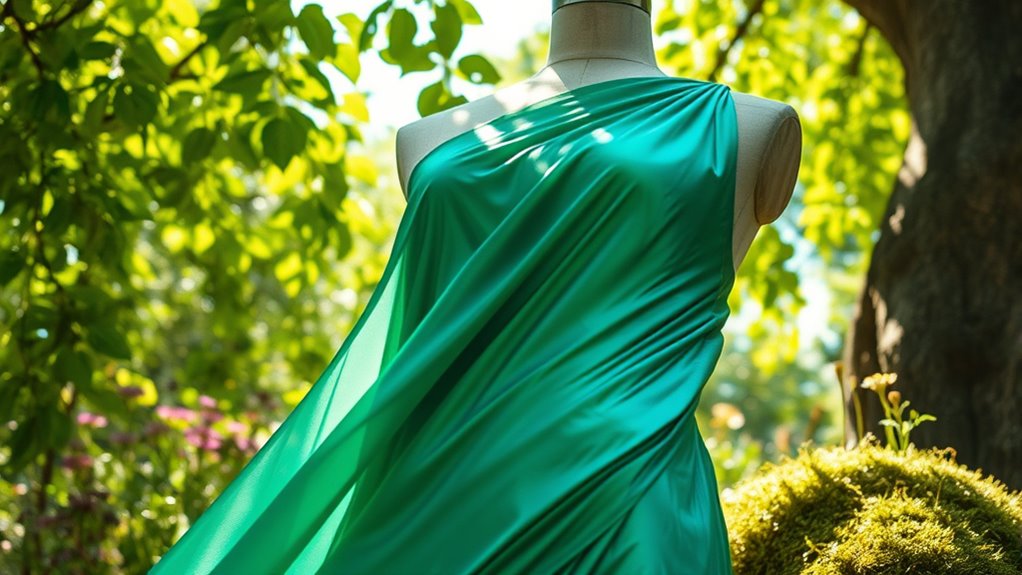In rewilding fashion, designers use regenerative materials like hemp and organic linen to create sustainable clothing. These materials not only minimize environmental impact but also promote biodiversity and healthier ecosystems. By prioritizing sustainable sourcing, you support brands that value both craftsmanship and the planet. Your choices as a consumer can empower eco-friendly practices and foster a deeper connection with nature. There’s so much more to discover about the transformative power of rewilding in fashion.
Key Takeaways
- Designers are increasingly using regenerative materials like hemp and organic linen to promote biodiversity and improve soil health.
- Regenerative materials help create a cyclical relationship between clothing production and ecological health, enhancing the environment.
- The use of sustainable sourcing practices in rewilding fashion minimizes environmental footprints and supports artisan craftsmanship.
- Storytelling around the origins of these materials emphasizes the importance of sustainability and eco-consciousness in fashion.
- Supporting brands that prioritize regenerative materials empowers consumers to promote eco-friendly practices and a harmonious relationship with nature.

Rewilding fashion is more than just a trend; it’s a movement that embraces sustainability and creativity in the clothing industry. As you explore this innovative domain, you’ll discover how designers are reshaping their practices to prioritize the environment and channel their creativity through regenerative materials. This shift isn’t merely about using eco-friendly fabrics; it’s about rethinking how clothes are made, sourced, and consumed.
Rewilding fashion transcends trends, championing sustainability and creativity while transforming how we make, source, and consume clothing.
When you explore the concept of sustainable sourcing, you’ll see it’s at the heart of rewilding fashion. Designers are actively seeking out materials that leave a minimal footprint on the planet. This means choosing organic cotton, Tencel, and recycled fibers over traditional, resource-intensive materials. As you consider your own wardrobe, think about how each piece is crafted. By supporting brands that focus on sustainable sourcing, you’re contributing to a system that values both the environment and the artisans behind the garments.
Incorporating regenerative materials also plays an essential role in fostering biodiverse ecosystems. You might be surprised to learn that some materials, such as hemp and organic linen, can actually improve soil health when cultivated responsibly. When designers commit to using these regenerative materials, they not only create beautiful clothing but also promote agricultural practices that enhance biodiversity. This cyclical relationship benefits the planet, allowing ecosystems to thrive and flourish.
As you navigate this landscape, it’s vital to recognize how your choices impact the larger picture. By opting for brands that align with the principles of rewilding fashion, you’re making a statement about the kind of world you want to support. Each purchase can empower sustainable practices and encourage a shift toward a more harmonious relationship between fashion and nature.
You’ll also notice that rewilding fashion isn’t just about using the right materials; it’s about storytelling. Designers are crafting narratives around their collections that highlight the journey of each fabric—from its origin to its final form. When you wear these pieces, you’re not just donning clothing; you’re sharing a story that reflects a commitment to sustainability and respect for the planet.
Frequently Asked Questions
What Are Regenerative Materials in Fashion?
Regenerative materials in fashion are those that promote sustainability through sustainable sourcing and material innovation. They’re designed to restore ecosystems rather than deplete them. You’ll find fabrics created from organic fibers, recycled materials, or bioplastics derived from renewable resources. By choosing these materials, you not only support ethical practices but also help reduce environmental impact. So, when you shop, look for brands that prioritize regenerative materials to make a positive change in the industry.
How Can I Identify Rewilding Fashion Brands?
You can identify rewilding fashion brands by looking for luxury labels that prioritize sustainability in their materials and practices. Check for celebrity endorsements, as many stars now champion eco-friendly lines. Browse their websites for transparency about sourcing and manufacturing processes. You’ll often find certifications indicating regenerative practices. When you wear these brands, you’re not just making a fashion statement; you’re supporting a movement towards a greener future.
Are Rewilding Fashion Items More Expensive?
Rewilding fashion items can be more expensive due to their sustainable materials and ethical production practices. When you do a cost comparison with fast fashion, you might notice these items often come with a higher price tag. However, consider the long-term benefits; investing in quality, eco-friendly pieces can save you money over time. It’s essential to weigh consumer affordability against the environmental impact of your purchases. Quality and sustainability often come at a premium.
What Are the Environmental Benefits of Rewilding Fashion?
When you embrace rewilding fashion, you’re weaving a tapestry of hope for our planet. The environmental benefits are profound: it supports wildlife conservation by using materials that protect natural habitats. You’re also playing a part in ecosystem restoration, rejuvenating the land that sustains us all. Each piece you wear symbolizes a commitment to harmony with nature, transforming your wardrobe into a vibrant statement for a healthier, more sustainable world.
Can Rewilding Fashion Be Sustainable Long-Term?
Yes, rewilding fashion can be sustainable long-term. By focusing on soil health and promoting biodiversity conservation, it helps create a balanced ecosystem. When you choose clothing made from regenerative materials, you support practices that enrich the soil and foster a diverse range of plant and animal life. This approach not only combats climate change but also guarantees that future generations can enjoy a healthier planet, making it a viable option for sustainable fashion.
Conclusion
As you explore the world of rewilding fashion, you’ll discover that using regenerative materials isn’t just a trend—it’s a powerful statement against the fast fashion cycle. Designers are proving that style can coexist with sustainability, challenging the notion that eco-friendly means sacrificing aesthetics. By embracing this innovative approach, you’re not only wearing something beautiful but also contributing to a healthier planet. So, next time you shop, consider the impact of your choices and join the movement toward a more responsible fashion future.










